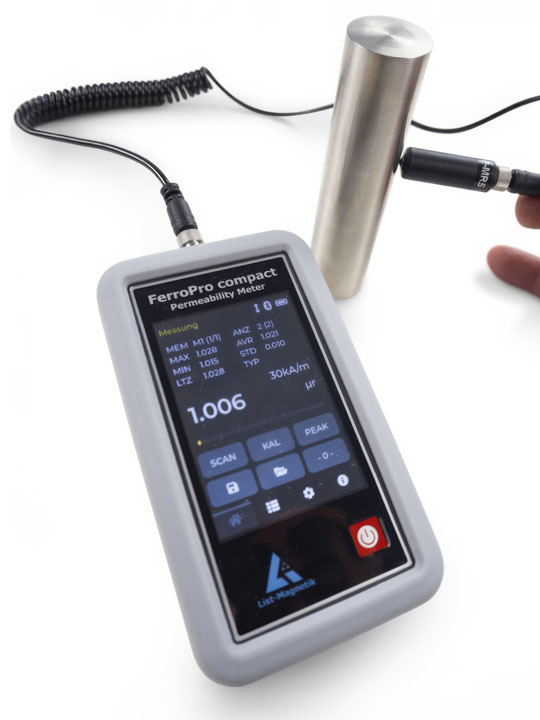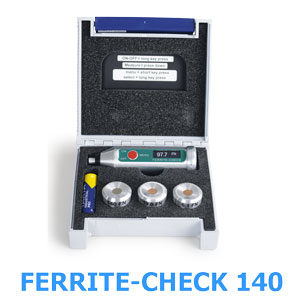A comparison of permeability and ferrite content
Permeability and ferrite content measurement are two methods used in materials science and metallurgy to characterize materials, particularly steels. These methods are used in various applications, such as materials testing, non-destructive testing (NDT), and non-destructive material testing, particularly for ferromagnetic materials.
Permeability Measurement
-
Definition
Permeability is the ability of a material to conduct a magnetic field. It is a measure of magnetic conductivity and plays a central role in testing ferromagnetic and non-destructive materials. NDT allows for the non-destructive analysis of magnetic properties, especially in steels. -
Measurement
In a permeability measurement, a magnetic field is passed through a material to determine the strength of the magnetic field generated within it. Relative permeability describes the ratio of magnetic induction (B) to magnetic field strength (H) in a material. The µ_r value of the material is measured here. This method can only determine µr values up to µr = 5.0. Higher permeability values cannot be measured this way because significantly stronger magnetic fields are required. Such measurements require a device that can record the material's complete hysteresis curve. -
Application
This measurement is used to investigate the magnetic properties of weakly magnetic materials, such as stainless steel and alloys. It provides information on the strength of the material's magnetism. Magnetic field strength can be precisely determined using magnetic field measuring devices, such as gaussmeters, teslameters, and magnetometers.
Ferrite Content Measurement
-
Definition
Ferrite content indicates the proportion of ferrite in a steel, which is usually either duplex or austenitic. Ferrite is a special magnetic phase in steel. Therefore, measuring ferrite content is an important method of material testing. It is frequently used in non-destructive testing (NDT) and in testing ferromagnetic materials, particularly for material analysis and quality assurance of welded joints. -
Measurement
Similar to the permeability measurement, the ferrite content is determined by an external magnetic field generated within the probe. The magnetic field measurement sensitivity is reduced to display higher ferrite content values, such as those found in austenitic steel. This magnetic measurement is based on the Basel standard, ISO 8249, and determines either the ferrite number (FN) or the percentage of ferrite in Fe%. -
Application
The ferrite content is crucial for controlling a steel's mechanical properties. For example, it affects toughness and corrosion resistance. A certain ferrite content is required in duplex steels to ensure the desired balance between toughness and strength.
Magnet Permeability Meter FerroPro compact |
Ferrite Content Meter FERRITE-CHECK 240 |
|---|---|
 |
 |
Magnet Permeability Meter FerroPro compact
To measure permeability, List-Magnetik offers the new, precise FerroPro Compact, which has an extended measuring range of µr = 1-5. During the measurement process, a permanently excited magnetic field is induced in the material. The disturbance of the magnetic field caused by the material is recorded, and permeability is derived from this data.
The new permeability measuring device features a high-resolution, color LCD display for visualizing scan measurement curves and graphs. It automatically stores and displays peak values and permeability curves, and it graphically displays them. The device measures permeability according to the EN 60404-15 and MIL-1-17214 standards, which are important for testing ferromagnetic and modern materials using NDT (non-destructive testing).
The excitation field strength of the probe varies depending on the standard. According to PTB, DIN EN 60404-15 uses an excitation field strength of 30 kA/m; according to NIST calibration, BN EN 60404-15 uses one of 25 kA/m; and MIL-1-17214 uses one of 200 Oe. Thanks to the device's integrated conversion of the field strength, the FerroPro Compact can perform standard-compliant permeability measurements according to all three standards for the first time.
The measuring system has an integrated memory for storing up to 10,000 measured values. This allows you to record measurement curves, individual values, or peak values directly on site and process them later. This is a significant advantage for materials testing and non-destructive testing (NDT).
One unique feature is the ability to remotely control the device via a USB-SCPI interface using programs such as LabVIEW or other SCPI-compatible software. This makes it easy to integrate the system into a production line, which is particularly attractive for automated materials testing processes.
The device has a wireless interface that can transfer stored data or online measurements to the supplied PC or app software. The measurement data and curves can be conveniently exported to Microsoft Excel for quality assurance and material analysis. This feature is extremely useful for non-destructive material testing and material thickness measurement.
The system offers two types of measurements: a scan measurement for continuous graphical recording of measured values, and a peak measurement for recording the peak value. It also displays the minimum, maximum, and statistical values.
The new permeability measuring device has many advantages in a variety of applications. Noteworthy features include the extended measurement evaluation options and the enlarged measuring range with various calibration curves for different excitation field strengths. All devices come with a manufacturer's certificate to support traceability and quality assurance in non-destructive material testing.
Ferrite Content Meter FERRITE-CHECK 240
One way to measure ferrite content is with ferrite scopes. These instruments are based on the principle of magnetic induction and determine the ferrite content by measuring the material's magnetic properties.
List-Magnetik offers the FERRITE-CHECK 240, a practical measuring device with a range of 0.2 to 140 FN. This precise device is ideal for testing and analyzing the quality of austenitic and duplex steels, particularly for non-destructive testing.
The basic measuring device has the same construction as the FerroPro Compact described above. However, the probe's design is fundamentally different. The FERRITE-CHECK 240 quickly and precisely measures the ferrite content of stainless and duplex steels according to the Basel standard, DIN EN ISO 8249, and the magnetic induction method. The device displays measurement results in both FN (ferrite number) and Fe-%. The measuring range extends from FN 0.2 to 140 (or Fe-% 0.2 to 100).
To detect a weld seam on smooth or polished surfaces, switch the device to scan mode. As the probe is moved along the surface, the device continuously records the measured values. Then, an automatic evaluation displays the minimum, maximum, and average values of the measurement series.
The device has a built-in memory for storing up to 10,000 measured values. This makes it ideal for materials testing, non-destructive testing (NDT), and comprehensive quality assurance.
It is particularly important to measure the ferrite content of welded duplex steels. This ensures the weld seam has enough ferrite for adequate strength. Insufficient ferrite content can impair the mechanical properties and corrosion resistance of the weld seam. Insufficient heat input or incorrect cooling in the welding area can result in too little ferrite, which weakens the welded joint. Therefore, ferrite content measurement plays an important role in materials testing and non-destructive testing to ensure the quality and durability of weld seams.
It is particularly important to measure the ferrite content of welded duplex steels. This ensures the weld seam has enough ferrite for adequate strength. Insufficient ferrite content can impair the mechanical properties and corrosion resistance of the weld seam. Insufficient heat input or incorrect cooling in the welding area can result in too little ferrite, which weakens the welded joint. Therefore, ferrite content measurement plays an important role in materials testing and non-destructive testing to ensure the quality and durability of weld seams.
With the FerroPro Compact and the FERRITE-CHECK 240, List-Magnetik offers two precise measuring devices that can quickly and reliably assess steel quality. Both devices are ideal for automated quality monitoring in production, ensuring safety, efficiency, and practicality.












